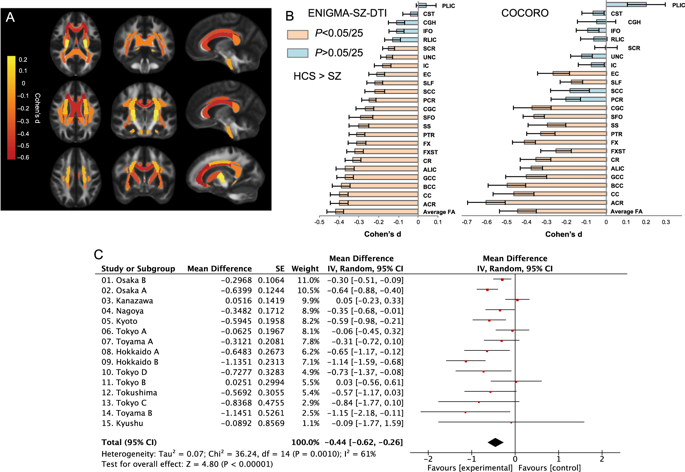当前位置:
X-MOL 学术
›
Mol. Psychiatry
›
论文详情
Our official English website, www.x-mol.net, welcomes your
feedback! (Note: you will need to create a separate account there.)
White matter microstructural alterations across four major psychiatric disorders: mega-analysis study in 2937 individuals.
Molecular Psychiatry ( IF 9.6 ) Pub Date : 2019-11-29 , DOI: 10.1038/s41380-019-0553-7 Daisuke Koshiyama 1 , Masaki Fukunaga 2 , Naohiro Okada 1, 3 , Kentaro Morita 1 , Kiyotaka Nemoto 4 , Kaori Usui 1 , Hidenaga Yamamori 5 , Yuka Yasuda 6, 7 , Michiko Fujimoto 5 , Noriko Kudo 7 , Hirotsugu Azechi 8 , Yoshiyuki Watanabe 9 , Naoki Hashimoto 10 , Hisashi Narita 10 , Ichiro Kusumi 10 , Kazutaka Ohi 11, 12 , Takamitsu Shimada 11 , Yuzuru Kataoka 11 , Maeri Yamamoto 13 , Norio Ozaki 13 , Go Okada 14 , Yasumasa Okamoto 14 , Kenichiro Harada 15 , Koji Matsuo 16 , Hidenori Yamasue 17 , Osamu Abe 18 , Ryuichiro Hashimoto 19 , Tsutomu Takahashi 20 , Tomoki Hori 21 , Masahito Nakataki 22 , Toshiaki Onitsuka 23 , Laurena Holleran 24 , Neda Jahanshad 25 , Theo G M van Erp 26 , Jessica Turner 27 , Gary Donohoe 24 , Paul M Thompson 25 , Kiyoto Kasai 1, 3 , Ryota Hashimoto 5, 7, 8 ,
Molecular Psychiatry ( IF 9.6 ) Pub Date : 2019-11-29 , DOI: 10.1038/s41380-019-0553-7 Daisuke Koshiyama 1 , Masaki Fukunaga 2 , Naohiro Okada 1, 3 , Kentaro Morita 1 , Kiyotaka Nemoto 4 , Kaori Usui 1 , Hidenaga Yamamori 5 , Yuka Yasuda 6, 7 , Michiko Fujimoto 5 , Noriko Kudo 7 , Hirotsugu Azechi 8 , Yoshiyuki Watanabe 9 , Naoki Hashimoto 10 , Hisashi Narita 10 , Ichiro Kusumi 10 , Kazutaka Ohi 11, 12 , Takamitsu Shimada 11 , Yuzuru Kataoka 11 , Maeri Yamamoto 13 , Norio Ozaki 13 , Go Okada 14 , Yasumasa Okamoto 14 , Kenichiro Harada 15 , Koji Matsuo 16 , Hidenori Yamasue 17 , Osamu Abe 18 , Ryuichiro Hashimoto 19 , Tsutomu Takahashi 20 , Tomoki Hori 21 , Masahito Nakataki 22 , Toshiaki Onitsuka 23 , Laurena Holleran 24 , Neda Jahanshad 25 , Theo G M van Erp 26 , Jessica Turner 27 , Gary Donohoe 24 , Paul M Thompson 25 , Kiyoto Kasai 1, 3 , Ryota Hashimoto 5, 7, 8 ,
Affiliation

|
Identifying both the commonalities and differences in brain structures among psychiatric disorders is important for understanding the pathophysiology. Recently, the ENIGMA-Schizophrenia DTI Working Group performed a large-scale meta-analysis and reported widespread white matter microstructural alterations in schizophrenia; however, no similar cross-disorder study has been carried out to date. Here, we conducted mega-analyses comparing white matter microstructural differences between healthy comparison subjects (HCS; N = 1506) and patients with schizophrenia (N = 696), bipolar disorder (N = 211), autism spectrum disorder (N = 126), or major depressive disorder (N = 398; total N = 2937 from 12 sites). In comparison with HCS, we found that schizophrenia, bipolar disorder, and autism spectrum disorder share similar white matter microstructural differences in the body of the corpus callosum; schizophrenia and bipolar disorder featured comparable changes in the limbic system, such as the fornix and cingulum. By comparison, alterations in tracts connecting neocortical areas, such as the uncinate fasciculus, were observed only in schizophrenia. No significant difference was found in major depressive disorder. In a direct comparison between schizophrenia and bipolar disorder, there were no significant differences. Significant differences between schizophrenia/bipolar disorder and major depressive disorder were found in the limbic system, which were similar to the differences in schizophrenia and bipolar disorder relative to HCS. While schizophrenia and bipolar disorder may have similar pathological characteristics, the biological characteristics of major depressive disorder may be close to those of HCS. Our findings provide insights into nosology and encourage further investigations of shared and unique pathophysiology of psychiatric disorders.
中文翻译:

四种主要精神疾病的白质微结构改变:对 2937 人进行的大型分析研究。
识别精神疾病之间大脑结构的共性和差异对于理解病理生理学很重要。最近,ENIGMA-Schizophrenia DTI 工作组进行了大规模的荟萃分析,报告了精神分裂症中广泛的白质微结构改变;然而,迄今为止还没有进行过类似的交叉疾病研究。在这里,我们进行了大型分析,比较了健康对照受试者(HCS;N = 1506)和精神分裂症患者(N = 696)、双相情感障碍(N = 211)、自闭症谱系障碍(N = 126)之间的白质微结构差异,或重度抑郁症(N = 398;来自 12 个站点的总 N = 2937)。与 HCS 相比,我们发现精神分裂症、双相情感障碍、和自闭症谱系障碍在胼胝体中具有相似的白质微结构差异;精神分裂症和双相情感障碍的特点是边缘系统发生了类似的变化,例如穹窿和扣带回。相比之下,仅在精神分裂症中观察到连接新皮质区域的束(例如钩束)的改变。在重度抑郁症中没有发现显着差异。在精神分裂症和双相情感障碍之间的直接比较中,没有显着差异。在边缘系统中发现精神分裂症/双相情感障碍与重度抑郁症之间存在显着差异,这与精神分裂症和双相情感障碍相对于HCS的差异相似。虽然精神分裂症和双相情感障碍可能具有相似的病理特征,重度抑郁症的生物学特征可能与 HCS 相近。我们的研究结果提供了对疾病学的见解,并鼓励进一步研究共同和独特的精神疾病病理生理学。
更新日期:2019-11-29
中文翻译:

四种主要精神疾病的白质微结构改变:对 2937 人进行的大型分析研究。
识别精神疾病之间大脑结构的共性和差异对于理解病理生理学很重要。最近,ENIGMA-Schizophrenia DTI 工作组进行了大规模的荟萃分析,报告了精神分裂症中广泛的白质微结构改变;然而,迄今为止还没有进行过类似的交叉疾病研究。在这里,我们进行了大型分析,比较了健康对照受试者(HCS;N = 1506)和精神分裂症患者(N = 696)、双相情感障碍(N = 211)、自闭症谱系障碍(N = 126)之间的白质微结构差异,或重度抑郁症(N = 398;来自 12 个站点的总 N = 2937)。与 HCS 相比,我们发现精神分裂症、双相情感障碍、和自闭症谱系障碍在胼胝体中具有相似的白质微结构差异;精神分裂症和双相情感障碍的特点是边缘系统发生了类似的变化,例如穹窿和扣带回。相比之下,仅在精神分裂症中观察到连接新皮质区域的束(例如钩束)的改变。在重度抑郁症中没有发现显着差异。在精神分裂症和双相情感障碍之间的直接比较中,没有显着差异。在边缘系统中发现精神分裂症/双相情感障碍与重度抑郁症之间存在显着差异,这与精神分裂症和双相情感障碍相对于HCS的差异相似。虽然精神分裂症和双相情感障碍可能具有相似的病理特征,重度抑郁症的生物学特征可能与 HCS 相近。我们的研究结果提供了对疾病学的见解,并鼓励进一步研究共同和独特的精神疾病病理生理学。











































 京公网安备 11010802027423号
京公网安备 11010802027423号